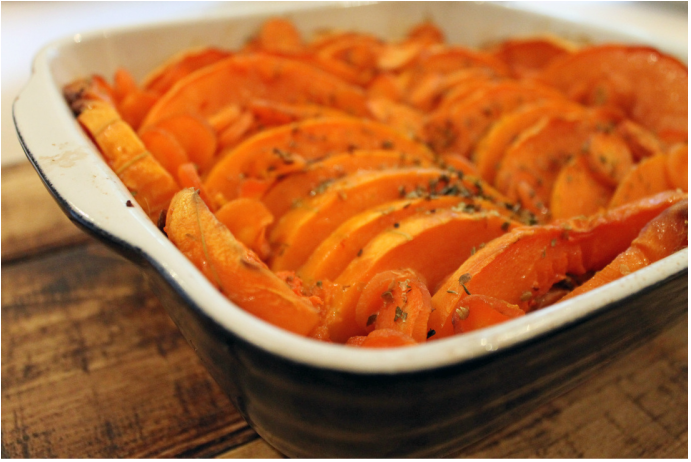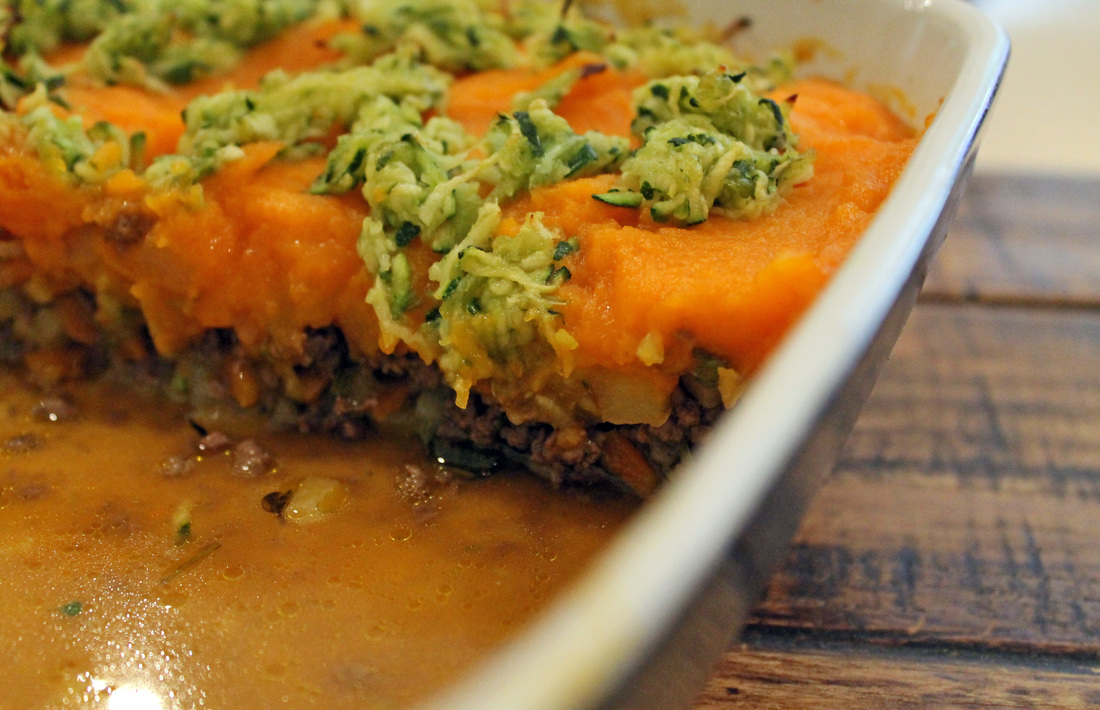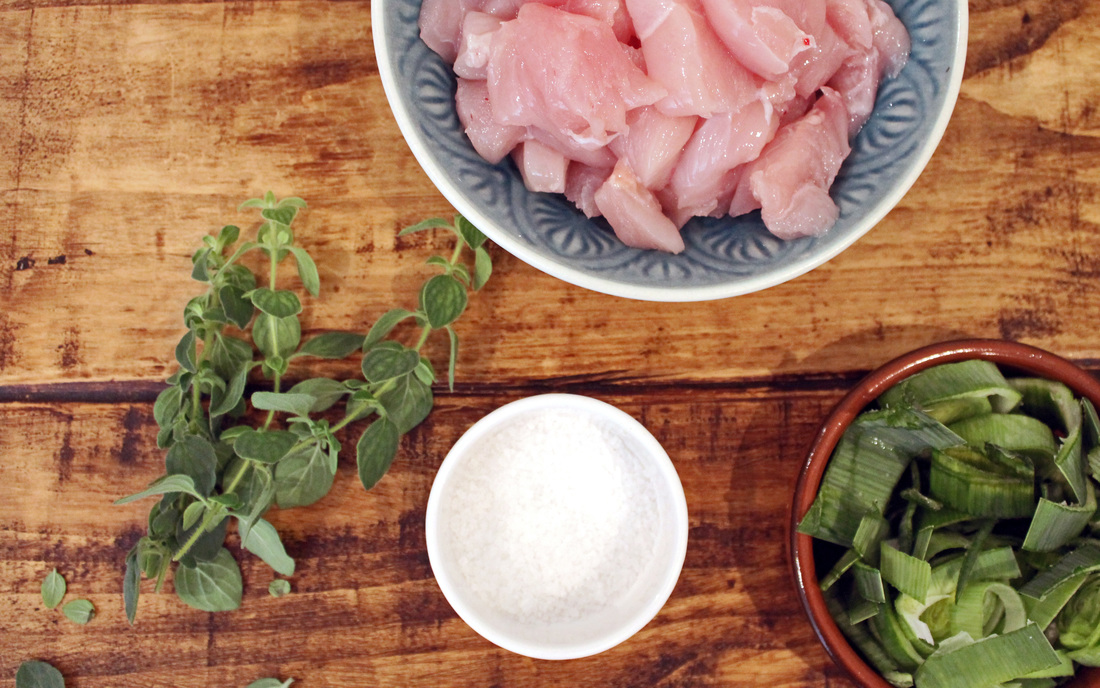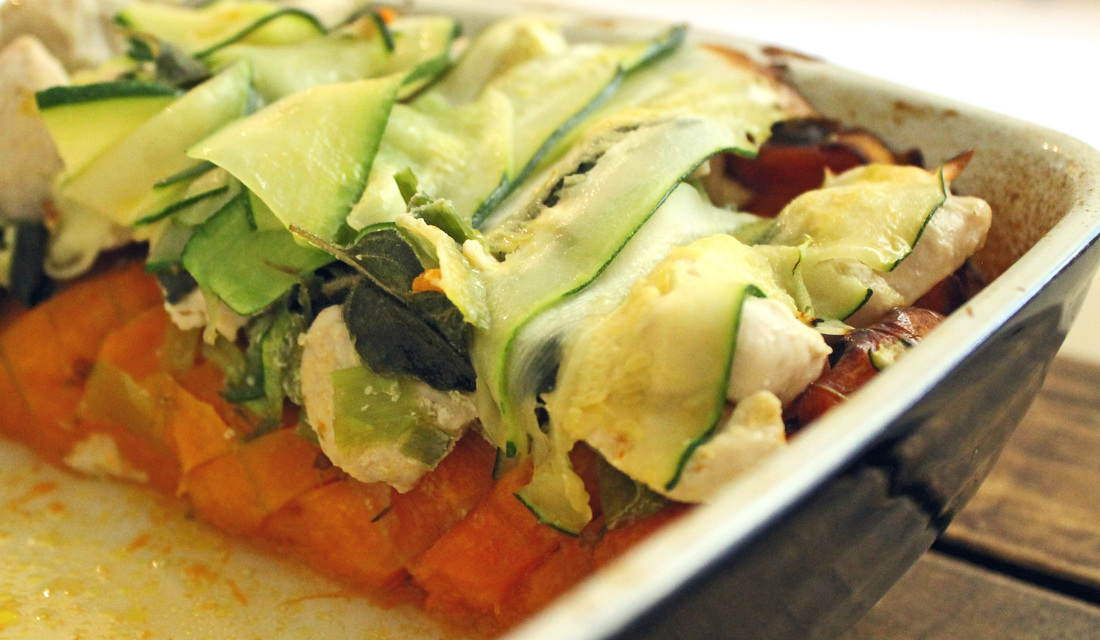Tangy salsa sauce (Paleo, AIP, low FODMAP, low histamine)
AIP, low FODMAP, low histamine tangy salsa relish
This has become a multi purpose staple for me in the absence of anything tomato based. You can use it to add a bit of flavour and thickener to sauces, on a meatza, as a burger relish and a general dipping sauce. Ingredients: 1 squash, halved and de-seeded. A sweet squash is best here such as a coquina. These are becoming more readily available in supermarkets. I have been able to get them from Waitrose, M&S, Ocado and Sainsburys. A quarter teaspoon of ground cloves A teaspoon of lemon juice A pinch of salt Optional: A tablespoon of garlic oil A tablespoon of coconut oil Dried herbs This is very versatile and you can add or subtract ingredients depending on what you need it for. To make the basic tangy salsa, preheat the oven to 200 degrees (180 for fan assisted). Roast your squash cut side face down for 50 minutes until soft. Scoop the flesh out of one half and add to a food processor with the cloves, lemon juice and salt. Blitz this together until you get a smooth thick sauce. Taste and add more seasonings as needed. If you want a thicker version to dip into like a hummus, omit the cloves and add a tablespoon of coconut oil and a tablespoon of garlic oil. Place this in the fridge to chill. The coconut oil will thicken to form a creamy dipping sauce. For a meatza sauce, follow the original recipe and add a tablespoon of garlic oil and some Italian herbs. You only need one half of the squash to create a good amount of dip/sauce. You can then utilize the other half of the squash in a different recipe.
1 Comment
Cottage pie (Paleo, AIP, low FODMAP, low histamine)
When I was a baby my Grandmother used to bring me miniature portions of her freshly cooked meals in little ramekin dishes. Everything was homemade and full of natural goodness, and my absolute favourite dish was her cottage pie.
Once the baby years were well and truly behind me I developed a taste for lazy cooking and microwaveable meals. Why spend the time slaving over a hot stove creating a cottage pie when you can microwave instant noodles? The valuable lessons here are: A. nutrition and its profound effect on your health. B: Grandma is always right. A cottage pie can be rich with nourishing ingredients to support your health. Better still, an AIP cottage pie can contribute to healing. Simply put, instant noodles will not. I have experimented with a few AIP, low FODMAP cottage pie recipes, but this is by far my favourite and tastes closest to the real thing. The hardest part is omitting the tomato and potato, but with some clever substitutions you can re-create almost anything. This version has a rich sauce packed with flavour and nutrition. This one's for you grandma. I have listed the ingredients below with a few cheat options if you are short on time. Otherwise, do the whole shebang; it’s really worth it. You can make this with beef for a scrummy, warming cottage pie or for an even richer dish you could create a shepherds pie by switching the beef for lamb. Serves 4. Can be re-heated thoroughly or enjoyed cold. Ingredients For the filling: 450g Minced grass fed beef or lamb - Grass fed meat is rich in omega 3 acids, B vitamins, magnesium, calcium, iron, Vitamin E and Vitamin A. 3 large carrots, diced into tiny cubes. Rich in Vitamin A and beta carotene Half a swede, diced into tiny cubes. A cruciferous vegetable rich in antioxidants and cancer fighting compounds. One whole onion or two leek tops (green parts only) for low FODMAP. Finely sliced. Being part of the same family, leeks offer many of the same health benefits as onions such as cancer fighting and heart protecting properties. Cheat – grate the carrots, leeks and swede in a food processor for a finer texture 275ml bone broth or reserved cooking liquid (see below) Bone broth is anti-inflammatory and heals and seals a damaged gut. Sea salt or pink Himalayan salt. Natural unprocessed salt should not be tarred with the same brush as table salt. Natural salt is packed with essential trace minerals. One tablespoon chopped fresh rosemary. Anti-bacterial, anti-inflammatory and anti-oxidant. One tablespoon chopped fresh thyme. An excellent source of vitamin C and fights infections. One tablespoon chopped fresh sage. A rich source of fibre and minerals. Supports cognitive function. One tablespoonAIP tangy salsa Two tablespoons Garlic oil One tablespoon of AIP friendly flour. I use tigernut flour, as it is one of very few flours that are both AIP and low FODMAP. Tigernuts are a rich source or iron, magnesium, potassium and many other minerals as well as being a good source of healthy fats. For the topping: One whole squash, halved and de-seeded. Coquina, acorn or queen squash for low FODMAP. Winter squash is packed with vitamin C and vitamin A, and is a great source of starchy carbs on an AIP diet. One tablespoon coconut oil. Anti-inflammatory, anti-microbial, anti-fungal, great source of fats, all round good guy. Sea salt or pink Himalayan salt Optional additional topping: I use this to cut through the sweetness on the squash topping. One whole courgette, grated. High in fibre and rich in antioxidants. One leek top – green parts only. Very finely sliced. Sea salt or pink Himalayan salt Teaspoon of lemon juice Equipment: A food processor for cheat options One large lidded frying or saucepan One baking tray/casserole dish Method: Pre-heat the oven to 200 degrees or 180 for fan assisted. Place your halved squash cut side down on an oven tray and bake for 50 minutes. After 50 minutes your squash should be totally softened. Scoop out the flesh into a bowl, and add a tablespoon of coconut oil and a pinch of salt. Give this a good mash until smooth and leave to one side. For the optional topping: I add this to the top of my mash to cut through the sweetness of a coquina squash, it adds an extra flavour element but also helps to create a cooking liquid if you are not using broth. Combine your courgette and leeks in a sieve over a bowl and sprinkle with a good pinch of salt and a teaspoon of lemon juice. Give these a good stir to combine and you will see the juices collect in the bowl. You can stir this intermittently and push the juices through the sieve. When you are ready to add liquid to your filling, use this topped up with water to make 275ml. While your squash is cooking, heat two tablespoons of garlic oil in a large saucepan over a low heat and add your sliced leeks/onion. Allow them to soften for 5-6 minutes before adding your cubed carrots and swede. Give these a good stir to ensure they are coated in the oil and let them soften over a low heat for 6 minutes. Remove the vegetables from the pan and add in your mince. Crank the heat up a little and brown the mince all over, breaking it up as it cooks. Once the mince is browned add your vegetable mix back in along with your chopped herbs. Add in a tablespoon of the tangy salsa puree and your AIP flour of choice. Give this a good stir so the flour starts to absorb the cooking juices. Gradually pour in your bone broth or reserved cooking liquid and throw in good pinch of salt. Stir everything thoroughly and turn the heat down to low. Put a lid on the pan and let it cook slowly for 25 minutes. After 25 minutes, transfer your mince mix to an ovenproof casserole dish and spoon your squash mash evenly over the top. If you have used the additional leek and courgette mix, sprinkle this across the top. Place this in the oven for 25 minutes and serve with steamed green vegetables or a summer salad. This is a great one to make at the weekend and put half to one side as a ready-made dinner for the week. Enjoy! Layered chicken bake (Paleo, AIP, low FODMAP, low histamine)
When I started writing this blog, I had several aims in mind. The main one being to share my story and my experiences. What I never intended to do was share recipes. I have never been much of a cook, in fact at times my cooking skills have left a lot to be desired. I spent many a year thinking the height of fine dining was sandwiching potato waffles with melted cheese. Waffle, cheese, waffle and repeat. Due to my drastic lifestyle change spending time in the kitchen and brushing up on some skills has became non –negotiable.
Given that I have found the AIP to be life changing I felt the need to share some recipes. What’s more, there is a severe drought of low FODMAP, AIP recipes – especially from the UK. So here I am, sharing some of my creations. God help you all. Layered chicken bake Serves 4, or two very hungry people. This can be re-heated thoroughly or even cold as a lunch with salad. This recipe is Paleo, AIP compliant, low FODMAP and low histamine. I have included optional variations where available. Ingredients 1 whole squash – for low FODMAP, use a coquina, onion or queen squash. If you are not low FODMAP a butternut squash or sweet potatoes would be a good substitute. Peeled and de-seeded and sliced into half moon shapes about 1 cm thick. 3 large carrots, sliced into discs. 3 tablespoons of garlic oil - this is low FODMAP! The fructans in garlic are soluble in water but not oil, making garlic oil a low FODMAP flavour godsend. One whole leek or for low FODMAP use 2 leek tops (green parts only) 4 chicken breasts diced into chunks One large courgette finely sliced into wide strips 2 tablespoons of extra virgin olive oil 2 tablespoon of coconut oil 3 tablespoons of bone broth or water 1 teaspoon of dried oregano A fistful of fresh oregano A fistful of fresh sage leaves Sea salt or pink Himalayan salt What do you need: A large oven proof baking tray/dish Frying pan Cheese slice Method: Pre-heat your oven to 180 degrees fan assisted or 200 degrees on a regular setting. Start by layering your squash slices across the bottom of your baking dish. These need to overlap slightly but not completely cover each other to ensure they cook through. Arrange your sliced carrots in between any gaps in the squash. Sprinkle the squash and carrots with a good pinch of salt, a teaspoon of dried oregano, 2 tablespoons of extra virgin olive oil, one tablespoon of coconut oil and 3 tablespoons of bone broth. If you haven’t braved the broth just yet, you should. But in the mean time, water will suffice. Pop this in the oven to bake for 50 minutes to an hour. Check on it at intervals and gently move the veg if necessary to ensure it is all coated and cooking but retain the flat layer. In the mean time slice your courgette with the cheese slice so you have wide strips and leave to one side. Ten minutes before your squash is ready, sautee your sliced leeks in a tablespoon of coconut oil and as they begin to soften add your diced chicken, 2 tablespoons of garlic oil and a good pinch of salt. You want to only just cook the chicken through so it is still soft and tender. Once the chicken is just about cooked and the leeks are softened, your squash should be ready. It should be soft and starting to caramelise around the edges. Remove the squash from the oven and layer your chicken and leek mixture on top including all the juices from the pan. The garlic oil will infuse with the juices from the roasted squash to form a sweet, garlicky sauce. Place your fresh sage and oregano leaves in around the chicken pieces. Cover your bake with your thinly sliced strips of courgette and drizzle with the remaining garlic oil. Place this back in the oven to finish cooking for 15 minutes. The bake is ready once the chicken is piping through and the courgettes are softened on top. This could be served with a salad or some steamed kale. Bon appetit! Addressing chronic inflammation naturally We all have one of those friends who you are practically legally bound to maintain a relationship with because you've known each other since you were three. One of those friends you’ve kept for years and years and you go for dinner with occasionally. You have absolutely nothing whatsoever in common, but they are around when you need them. You can enjoy their company in short bursts, but too much time together and they really start to grate on you. A chat over coffee - great, a two week holiday - no chance.
Inflammation is one of those friends. There are times when we really appreciate it being around. It rushes to our assistance when we are wounded to prevent infection setting in, and fights our corner against bacterial invasions. This normal, healthy response is classed as acute inflammation. It doesn’t hang around for long, just does its job and passes through. This inflammation becomes problematic though when it becomes widespread throughout the body and takes up permanent residence. This is known as chronic, systemic inflammation. Chronic inflammation is now deemed to contribute to almost every major health condition you can think of. From asthma & allergies to cancer and cardiovascular disease. Of course it is also a key contributer in the development of most Autoimmune conditions such as Lupus and Rheumatoid Arthritis. Systemic inflammation such as this is stealth like. It spreads silently throughout the body inflaming and aggravating bodily tissue and your joints, whilst for the most part you remain oblivious. It can take many years before symptoms become apparent and other conditions develop as a result. What causes chronic inflammation? It occurs when the immune system initiates an inflammatory response unnecessarily, when no real threat is present. As well as an immune system gone awry, chronic inflammation is rooted in an unhealthy, unbalanced lifestyle. The main offenders being: Inflammatory foods (quelle suprise) Gluten Refined sugar Pasteurised dairy Processed food Conventional and processed meat Trans fats Nightshades (in certain individuals) If you are suffering systemic inflammation, eating these foods repeatedly will just serve to fan the flames of inflammation in the gut. Not only does this contribute to leaky gut, but also has a direct impact on the blood/brain barrier. Your gut and brain are inextricably linked, and when chronic inflammation is present in one you will invariably find problems with the other. When your digestion suffers you may start to notice brain fog, depression and other mental health concerns. Taking down the total body inflammation will support both gut and brain health to alleviate these symptoms. As well as poor dietary choices, other factors play a part in keeping your body in a constant state of inflammation. Obesity Smoking Allergens Excess stress from work, money, poor relationships A sedentary lifestyle with little/ no exercise Underlying chronic infections Unbalanced ratios of omega 3 vs. omega 6 (omega 3 is anti inflammatory - too much omega 6 is inflammatory) Not getting enough sleep I imagine most, if not all of us can hold our hands up to a good chunk of that list. How can I reduce inflammation? As we are learning here, drugs are rarely the answer and only serve to mask your symptoms at best. At worst they exacerbate existing health problems further. The aim here is to exercise some damage control and tame the response. There are some simple steps you can try to incorporate into your daily routine to help manage and reduce chronic inflammation. An Anti – inflammatory diet Both the Paleo and AIP diet are naturally anti-inflammatory. Not only do they eliminate most dietary irritants, but also they focus on consuming rich, nourishing foods with anti-inflammatory properties. Ensure you are getting a good amount of high quality animal based omega 3. Ideally getting this from fish is preferable to buying a fish oil as the quality of these is often questionable. Equally grass fed animals are also a rich source of omega 3, as opposed to conventionally raised meats. Exercise regularly. Exercise naturally supports the reduction of inflammation. Ensure you are getting sufficient vitamin D. Spend enough time out doors every day or you may wish to supplement where necessary. Don’t smoke. Just don’t. Ever. Support detoxification through diet Supplement your diet with anti – inflammatory herbs Manage stress levels through positive practices such as yoga and mindfulness Prioritise sleep habits and ensure you get enough rest As well as adopting a natural whole foods approach to ease inflammation, there are certain foods that are anti inflammatory power houses and you should place an emphasis on incorporating more in your diet: Ginger – calms the immune response and soothes joint inflammation Turmeric – a portent anti-inflammatory. Be careful it stains EVERYTHING it touches. Blueberries – low in fruit sugars but high in quercetin – a potent anti-inflammatory, which also supports the reduction of allergies. Green leafy vegetables – such as kale and spinach. Rich in antioxidants vitamin A and C. Coconut oil – rich in antioxidants and anti-inflammatory compounds. Anti bacterial and anti-fungal to boot. I use this for everything you could possibly imagine, from make up remover to oiling squeaky door hinges. Bone broth – heals the gut and provides a natural dose of anti-inflammatory, gut repairing, L glutamine. Wild caught Salmon – rich in essential fatty acids and omega 3’s Beetroot – high in compounds which inhibit the body’s inflammatory response Garlic – anti bacterial, anti –inflammatory and anti – fungal. Just avoid if you are low FODMAP. Shiitake mushrooms – prevent inflammation and inhibit oxidative stress If you are able to implement both dietary and lifestyle changes you have a fighting chance of dramatically reducing inflammation throughout the body. As a result you will start to notice a reduction in symptoms of chronic pain and disease associated with inflammation. A gluten free guide to ParisIf you have been lucky enough to cast your eyes over my healing journey post, you will know that I spent a few days in Paris before commencing my AIP diet.
Paris, for those of you who have never been, is everything you could ever want from a city. Past meets present at every turn and it does this stylishly and gracefully in a way that other cities cant seem to master. The city is so vast that if you really wish to immerse yourself in all its glory, you need to stay for a week. If you are happy to roam aimlessly and soak in a few sites, hop between cafes and people watch, then a weekend break will do the trick. I had visited Paris twice previously, but this time round, I was taking my husband on his very first French jaunt. I was so excited to show him this magnificent city that I planned a brutal itinerary that would have punished even the most hardened traveller. We were staying in the Saint Germain district, which is the perfect combination of classical Paris and contemporary chic. We left our luggage in our hotel and headed straight for lunch. I had pre picked a gluten free, coeliac friendly establishment for every meal during our stay and our first stop was the Galette cafe. To you and I, a galette is a sort of dense, savoury pancake. They are not your standard wheat based crepes, galette's are typically made from buckwheat flour making them naturally gluten free. The menu is a mouth-watering feast for coeliac's and offers a selection of typically decadent, flavoursome, typically French ingredients to adorn your pancake. If you are GF/Coeliac and fancy something authentically French this is a great spot for lunch. I would recommend pre-booking though as it can get busy. If you are on a Paleo or AIP diet however, this is not the best spot for you. It's a good job I had my fill of galette's before I realised the need for the AIP. We ambled about a busy, yet chilled St. Germain for a while before heading to Notre Dame where we left our mark on the Pont Des Arts with a personalised padlock. We managed to make this gesture just in time as shortly after the locks were cut away due to the structural damage they were causing the bridge. I like to think the hefty lock I purchased was not the straw that broke the camels back. That evening, to welcome my 30s in in style, I had located an entirely gluten free fine dining restaurant. Somewhere I would feel free to indulge to my hearts content without the persistent underlying fear of being glutened that follows me into every restaurant. The restaurant 'Noglu' (see what they did there?), not only offers fine dining but also separate from this has its own GF bakery. Since my visit, they have also set up shop on Madison Avenue, New York. Before I go any further, a word about Google maps. Paris is a pretty big place and it's easy to get lost, by I rate my map reading skills quite highly. I have been known to print screenshots of Google maps and carry them around to get me from A to B. This was one of those times. It was the evening of my 30th, I was in Paris, I was hungry and I was heading for the first 100% gluten free restaurant I had ever been to. My reservation was for 19:30, I had been gluten free for two years, strictly low FODMAP for one and now I was on a mission to indulge. But Google maps failed me spectacularly. We zigzagged back and forth across the same busy Parisian street, got lost down alleyways and took direction from people who seemingly weren't giving us directions at all. Merely pointing vaguely into the distance so we would leave them alone. We were now 15 minutes late for dinner. I could feel the emotion bubbling up inside as we literally went round and round in circles. 15 minutes became half an hour and the bubbling emotions erupted into tears. I was tired, hungry and panicking about where would end up eating and devastated that my birthday plans were ruined. Just as we were about to admit defeat, it appeared, in all its tiny boutique glory. We were there, half an hour late, expecting to be turned away, with enough mascara running down my face that I could be mistaken for Alice Cooper. The menu was small, but beautiful. We watched them prepare our dishes in an open kitchen and each looked like a work of art. We had starters of cured fish, avocado and salad, followed by a main of duck breast with root vegetables. It was faultless. It wasn't just the food that made it special, half the pleasure came from knowing that it was all safe and there was no risk of cross contamination. And then there was dessert. I hadn't let an ounce of sugar or chocolate pass my lips for a year, but have I mentioned it was my birthday? I opted for the chocolate fondant. My god. It was an eruption of unctuous, velvety rich, molten chocolate encased in the most perfectly soft and moist sponge. I would never have thought gluten free could taste THAT good. If you find yourself in Paris on a GF diet then coming here isn't even up for debate. What's more, if you are on a Paleo or AIP diet, you will find plenty of choices too. My only recommendation would be that you take a proper map. On our second day, we were to execute my heinous itinerary with strict military precision. We were basically attempting Paris in a day. An early morning hike took us across Paris to the Eiffel tower, then all the way over to Montmartre and a picnic at the foot of the Sacre Coeur. The afternoon saw us headed to the Louvre. By the time we hit the gallery I had exhausted us both and we had lost the will to live. We queued to get into the Louvre and then only spent half an hour in there before we were ready to drop. We spent more time queuing for the toilets than browsing the art. We decided that if nothing else we needed to see the Mona Lisa before we left and proceeded to sprint around the gallery in a fashion that both resembled a scene from the Da Vinci Code and an episode of challenge Anneka. We somehow managed to make it back to our hotel, weary and defeated. The evening itinerary was to take us to a GF friendly restaurant alongside Notre Dame, but even the thought of having to go anywhere made our legs melt. We were in a busy district in one of the most fabulous cities in the world. Surely there would be an abundance of local restaurants prepared to cater for me. Armed with my French coeliac card we ditched our evening plans and hit the streets of the local neighbourhood. We aimlessly strolled for about 20 minutes gazing at menus, none of which were looking that friendly. This was proper French cooking, complex and intricate. I daren't ask for anything other than what was on the menu for fear of insulting the cuisine or the chef. We finally came to a restaurant that offered a simple menu of meats, fish and vegetable dishes. Perfect. Immediately upon entering the building a waiter greeted us, except it was less a greeting and more an eyeballing. I requested a table for two and handed him my coeliac card. He scanned it with disdain, as the initial look of bemusement became one of sheer disgust. He looked up at me, handed back my card, and without even the vaguest flicker of compassion said 'NO'. I asked him if that meant we couldn't eat there, he stated that we could not, it wasn't an option and they would not be able to cater for me. And that was that. To say I was taken aback would be an understatement. I had never been outright dismissed from a restaurant before. My furious hunger wasn't going to deter me so we kept walking past the same restaurants, almost hoping something might appear that we had missed before. We had previously dismissed an uninspiring looking burger and steak house for its lack of character and soul, but this now looked as good an option as any. Plus I was getting hangry. On entering the bar I handed my coeliac card over to the stoney faced waiter. It came again 'NO' I genuinely could not believe this was happening. I was actually being turned away by restaurants as if I were some kind of contagious rabid monster. Queue some more tears. Now I would like to point out that prior to establishing my perfect diet, I cried frequently. My hormones and emotions were all over the place. But I would also like to point out that it’s perfectly ok to get upset in these situations. Nobody should feel like they are being punished because the have an autoimmune condition or food intolerance. We headed back to our hotel wondering if my only option was to now order room service and pick through the bits that I could eat, and hugely regretting the decision to ditch our original dinner plans. Across the street from our hotel was an Italian restaurant - La Giara. Being very much of the mind frame that if you don't ask, you don't get and without any other alternative, I approached the waiter. I presented my coeliac card to a brusque Italian. I knew my chances were slim in a restaurant that makes a great deal of its living from feeding people gluten. He looked up and said ‘yes yes. Of course’ Have you booked a table? The initial euphoria was short lived as I realised we weren’t going to get a seat anyway. I told him no and he huffed and puffed about for a few seconds, before asking us to follow him. He hurriedly seated us at a table. I got the impression we were going to eat, and eat fast. He offered to adapt whatever I fancied from the menu and my faith in humanity was restored. Shortly after being seated, what was an empty restaurant became packed to the rafters. I was so grateful to have been offered a table and more importantly offered some food. I decided to play it safe and requested a steak, which was perfectly cooked and served with some sautéed Mediterranean vegetables, doused in generous lashings of olive oil. I was one happy coeliac. Looking around, this was clearly a popular choice with locals and tourists alike. If you find yourself in the area of St Germain and are looking for a meal then I can safely say these guys are very accommodating and you won't be disappointed. The following morning was our last so we packed our bags and set out for brunch. Our final GF destination was to be 'Helmut Newcake' an entirely GF patisserie and cafe serving up brunch and lunch. After more fun and games with Google maps, we found it tucked away from the main strip in a predominantly residential area. It is a little ray of sunshine at the end of a fairly non-descript street. Though small, the cafe is bright, airy and welcoming. And much like Noglu, I felt I was in safe hands. The cakes were all lined up in a glass display cabinet like little Christmas tree decorations - they almost looked too good to eat. It was everything you would expect from a Parisian patisserie, minus the accompanying tummy ache. We sat down to brunch, which was brought to us in stages. An assortment of teas and fruit juice was on offer, a selection of gluten free breads and pastries with preserves, ham, cheese, bacon, smoked salmon, eggs and salad. It was by far the most decadent breakfast I had ever had - coeliac or not. Every mouthful was a pleasure and a total treat. And what’s more the price was totally reasonable given the standard. Deep down inside I knew that I hadn't truly found the answer to my healing and I knew that somewhere down the line I would most likely pay the ultimate price for this moment of food weakness. It is an emotional experience being diagnosed as a coeliac or with any autoimmune condition and for the moment at least I was happy to enjoy eating the way I once did. I suppose it was a bittersweet experience knowing I wouldn't do it again. And then came the piece de resistance. A little cloud of choux pastry dipped in icing and sprinkled with caramelized toffee, oozing sweet custard. If I had the stomach for it I would have bought up the entire cake counter. But this was more than enough for me and I was truly content. This is an absolute coeliac heaven if your digestion can take the treats, but even if you are Paleo or AIP, there will be at least some options available to you with the added bonus of knowing the kitchen does not contain a single trace of gluten. I would highly recommend Paris to anyone - It truly is a magical city. But it is also one of the harder cities to dine in off the cuff with a food sensitivity. It most certainly has options available on a gluten free, Paleo and AIP diet but as always I would exercise caution and pre plan to avoid disappointment. |
Emma CarterThis blog tells an ongoing story about me and my journey back to health and happiness. A boho soul always looking for my next European adventure. I am a Coeliac, Yogi, paleo advocate, dreamer, Bon jovi connoisseur, sun worshipper, snuggly jumper wearer and wife to my lovely Paulie. Archives
April 2017
Categories
All
|










 RSS Feed
RSS Feed